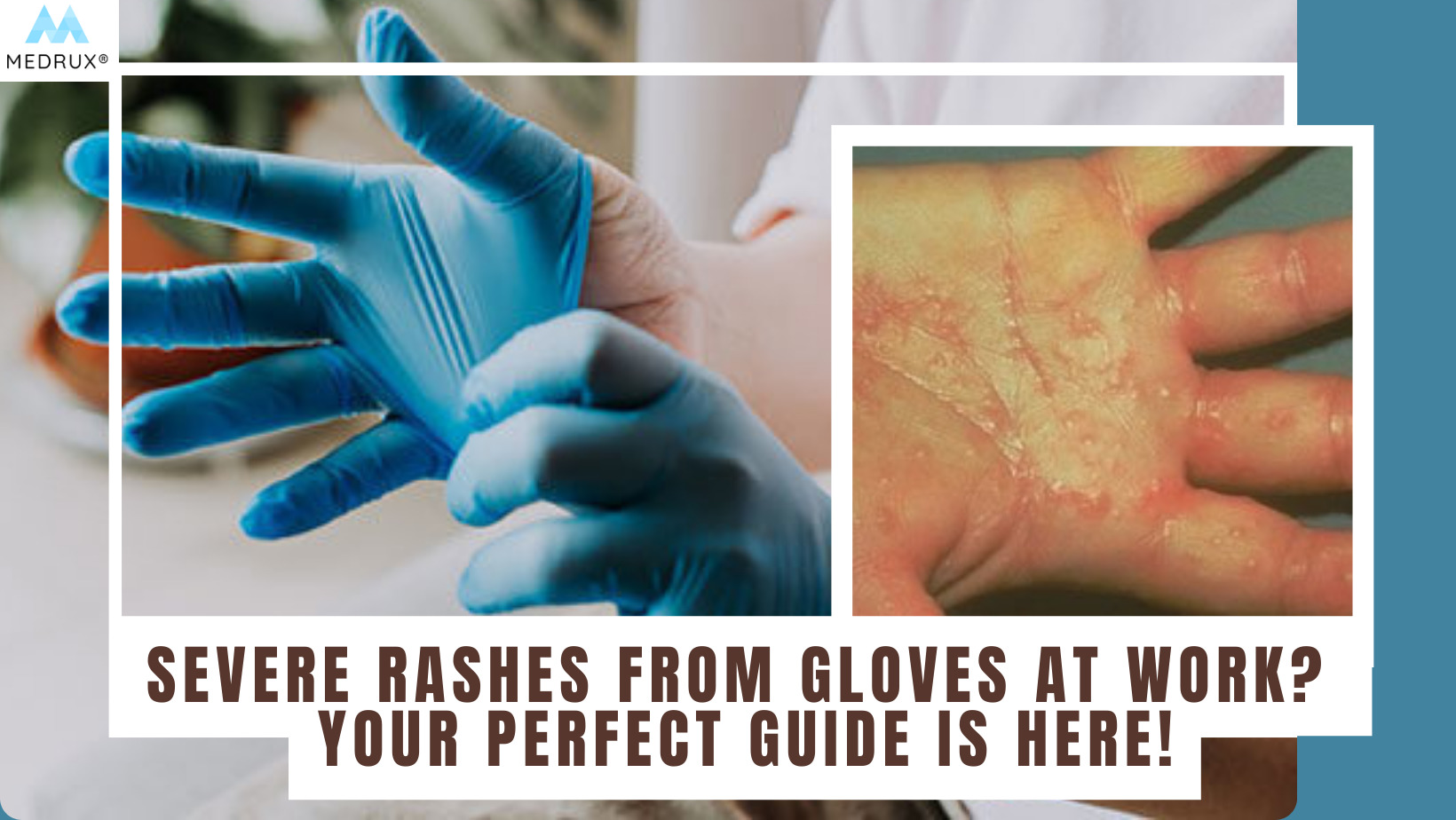Anti-vibration gloves have been a very intriguing topic in the industrial world.
Whenever it is brought up, it must be associated with synonyms like “hand-arm vibration” and “white finger syndrome.”
Have you ever felt your fingers tingle a little while spending some time trimming the grass on your lawn or using a lawnmower?
I bet you can already feel the vibration and tingling sensation as I say these words, right?
Whether going for a long ride on your bike, using your lawnmower, or even working with a driller to make a few holes to hang a picture on the wall, you must have felt the numbness and tingling in your hands and arms at some point.
When you google this, you will either be terrified of losing your hand sensations or swamped with people debating whether anti-vibration gloves should be required in workplaces.
Let me tell you more about the whole thing. It’s going to be a fun journey. Bear with me here.
In this article, we will talk about the following:
- What is a hand-arm vibration syndrome?
- What are anti-vibration gloves?
- Standard testing of anti-vibration gloves
- Limitation of the anti-vibration glove testing standard
- Anti-vibration gloves Are they practical?
- Anti-vibration gloves Can we rely on them?
- Do anti-vibration gloves cause more harm than good?
- Why should you wear anti-vibration gloves?
- How to reduce and avoid the risk of vibration
- Best six anti-vibration gloves.
What is a hand-arm vibration syndrome?
Sometimes abbreviated as “HAVS,” it is a syndrome that causes changes in the sensation of fingers, hands, and arms.
The symptoms of HAVS are presented as follows:
- Numbness
- Tingling sensations
- Discoloration of fingers
- Muscle fatigue or weakness
Occasional use of vibrating machinery can only cause this tingling and numbness for a few minutes or hours.
However, frequent and prolonged use of hand-held vibrating tools such as chainsaws, jackhammers, pneumatic drills, power drills, or any machinery that vibrates can lead to more severe and sometimes irreversible damage.
It’s not clear how vibration causes all this. Indeed, it can be because of repeated minor injuries to the small nerves and blood vessels in the fingers.
It can develop over as little as six months, depending on the frequency of exposure to vibration and the severity of it, but usually, it takes years.
HAVS could lead to permanent numbness of fingers, muscle weakness, and sometimes a more severe condition called Raynaud’s syndrome, in which blood circulation to the fingers is lost or affected.
This syndrome leads to a loss of sensation and talent and a change of the finger’s color to white. That’s why it’s also known as “white finger syndrome.”
It’s a painful condition; it can worsen over time and permanently damage the fingers. In severe cases, it could turn the skin gangrenous.
Imagine not being able to perform simple daily activities such as tying your shoes, dressing, or preparing a meal!
Sometimes, people who use these vibrating tools may suffer from a loss of grip strength and decreased dexterity. They can no longer hold things up.
Similarly, this can be a risk factor for developing arthritis, tendonitis, and carpal tunnel syndrome (CTS).
Work-related Carpal tunnel syndrome (CTS) is a leading cause of disability. (1)
It happens when the nerve-controlling sensation and movement in the thumb and first three fingers are strained or compressed. This results in numbness, tingling, weakness, or pain in hand.
It could disrupt hand function and the person’s ability to work or perform simple daily activities.
So, who is at risk of developing HAVS?
Anyone whose daily job requires handling vibrating machinery has the potential risk of developing HAVS.
Meanwhile, higher HAVS-risk occupations include construction, sheet metal work, welding, automotive repair, and electrical work.
It’s estimated that half a million construction workers in the U.S. are at risk of developing HAVS (2)
The bad news is, because it’s a slow and long-term progression, it’s not often discovered until the damage is done.
More precisely, it’s challenging to predict it among individuals.
Why?
Different variations in people lead to different severity levels of symptoms.
You can work your entire life with vibrating machines, yet you can be lucky enough not to develop HAVS symptoms.
While others, which are not as fortunate, can be more susceptible to being affected and show symptoms much earlier despite not working with vibrating tools very often.
Are you terrified and looking for ways to avoid this?
The good news is that anti-vibration gloves have to lead you right here.
Please don’t be scared; it’s possible to avoid developing HAVS.
Let’s see how.
What are anti-vibration gloves?
Anti-vibration or vibration-resistance gloves are particular types of gloves or personal protective equipment (PPE).
They absorb and dampen some vibrations from the work tools, such as hammers, drills, grinders, and sanders.
Why?
To help reduce the harmful vibrations transmitted to the hands of the workers.
There are different anti-vibration gloves on the market nowadays, using other methods to reduce injuries, such as:
- Multiple layers of viscoelastic urethane polymer called Sorbothane
- Air pockets or bladders made of urethane absorb the vibration before they reach your hand.
The most popular types use simple foam padding, resilient gel, or rubber-like materials that achieve the same idea.
They’re used in heavy industries like construction, mining, and oil and gas.
We can categorize them according to the material into the following:
-
Anti-vibration Gloves made of Coated Fabric
They’re called “general-purpose gloves.”
Not only do they protect from vibrations, but they also offer a high level of cut and puncture resistance.
It also has better chemical resistance than regular fabric gloves.
Some choices for the coating material are latex, PVC, polyurethane, and nitrile.
- Anti-vibration Leather gloves
Anti-vibration leather gloves are tough and durable.
They resist vibration and offer excellent grip and heat resistance.
They are resistant to vibrations, cuts, and abrasions.
-
Synthetic, rubber, or plastic anti-vibration gloves.
These form-fitting anti-vibration gloves protect you from vibration, oils, grease, solvents, chemicals, and microorganisms.
Standard testing of anti-vibration gloves
In light of all this, the world has become more and more aware of the seriousness of this problem, especially since nearly 2 million people are at risk (3)
The PPE industry has been working to develop testing standards for anti-vibration gloves.
They developed global standards called ANSI/ISO STANDARD ANTI-VIBRATION GLOVES.
For a glove to be called anti-vibration, it must be tested to meet the requirements of the international organization of standardization (ISO)-10819 and ANSI S2.73.
This test measures how many vibration frequencies can be transmitted through the alleged “vibration-reducing” materials that cover the palm, fingers, and thumb.
Strangely, the test measures the vibration transmitted from the machine’s handle through a glove to the palm.
The requirements for anti-vibration gloves include the following:
- Full-fingered design
- Uninterrupted palm padding from base to fingertips.
- Palm padding is ≤ 8mm thick
- The fingers and thumb padding should be ≥ 0.55 times the palm padding thickness.
- The glove must not amplify the vibration in the medium frequency range.
- The gloves should reduce medium-range frequencies (1.5Hz to 200Hz) by ≥ 10% vs. the bare hand.
- The gloves should reduce high-range frequencies by ≥ 40% vs. bare hand
Notwithstanding, the test has some significant limitations that make many people doubt the use of anti-vibration gloves.
Let’s go through them.
Limitation of the anti-vibration glove testing standard
-
The test measures the vibrations transmitted through the palm only
The beat will likely be sent to all areas of the hand in contact with the vibrating surface, not just the palm.
-
Anti-vibration Gloves’ performance differs from one user to another.
Some factors, such as the physical characteristics, the diverse postures, the changing grip, the push force, and the different techniques used by individuals, may affect how much vibration can be transmitted through the gloves.
-
Anti-vibration Gloves’ performance differs with different tools.
Anti-vibration gloves will be used with various tools such as drills, hammers, etc.
Transmission with each of these tools could be completely different with different frequencies depending on how the device is used and the factors affecting the vibration coming from, for example:
- Speed of rotation of grinders.
- The number of impacts per second for demolition hammers.
Likewise, the quality and maintenance state of the tool used can significantly impact the performance.
-
The direction of the vibrations moving from the device to the gloves.
Even though the test considers the vibrations in all orders.
The shear direction is not considered.
Studies have found that the transmission to the hand-arm system is different when the anti-vibration glove material is tested in shear.
In other words, it runs parallel to the glove’s surface through a gripped hand.
-
The test is done under controlled conditions.
ANSI/ISO-certified gloves are tested in a lab under specific conditions, so they do not measure the number of vibrations the gloves should protect against.
Bottomline;
it’s nearly impossible to predict the performance of anti-vibration gloves in different situations.
And to take into consideration all the other aspects that could affect how and how many vibrations are transmitted, the test must be performed on-site
Which is not practical at all.
You’re probably wondering if you should buy anti-vibration gloves or if they even work.
Well, you should eventually.
In any case, let’s take it one step at a time by answering a few questions.
Are anti-vibration gloves practical?
Few glove designs reduced vibration transmitted to the palm in a study conducted by the National Institute for Occupational Safety and Health (NIOSH) to assess the efficacy of anti-vibration gloves (4)
The efficacy was highly dependent on many factors, including the tool used and the number of vibrations generated.
Moreover, anti-vibration gloves reduce high-frequency vibrations from tools such as grinders, sanders, and saws.
Nevertheless, they don’t work well with tools such as tampers, chisels, pavement breakers, rammers, and vibrating forks.
These tools vibrate at lower frequencies, which are more dangerous to the hands.
In particular, Anti-vibration gloves only protect some parts of the hands. They are better at preserving the palms than the fingers and fingertips.
Likewise, the thicker the anti-vibration gloves, the more effective they reduce vibration transmission.
However, with thicker gloves, workers may need to increase the grip force, which might cause more fatigue and increase the risk of injuries such as CTS.
Further, the thickening affects the talent needed to work safely with the machines.
Therefore, they won’t protect you against vibration if they are too thin, and if they’re too thick, they might cause fatigue.
Can we rely on Anti-vibration gloves?
The simple answer to this is no!
Why?
Despite the effectiveness of this study, it was also under certain circumstances and highly dependent on many factors.
As a result, NIOSH concluded that anti-vibration gloves could not be relied on to provide adequate protection and recommended that other vibration control methods be implemented first.
This lines up with what the Washington state department of labor and industries stated: “Anti-vibration gloves are inefficient at reducing vibration hazard to the hands and arms.” (5).
And as we mentioned above, it’s not that easy of a task to assess the vibration reduction by the anti-vibration gloves, so you should not rely on them to protect you from vibration.
Do anti-vibration gloves cause more harm than good?
The HSE regulations advise employers not to rely on anti-vibration gloves because they cannot protect against vibration in most situations and may cause more harm than good.
How?
When an employer relies on gloves believing they will protect their employees, they overlook the control measures required to reduce vibration risk, which will undoubtedly do more harm than good.
Similarly, research showed that anti-vibration gloves respond differently at the fingertips compared to the palms.
And in certain circumstances, they increase the number of vibrations at the fingertips rather than lower them.
Why should you wear anti-vibration gloves?
Anti-vibration gloves can reduce high-frequency vibration, so they are helpful with many tools.
Additionally, protect your palms against vibrations.
What’s more, extreme cold can reduce blood flow to the fingers, which is associated with an increased risk of developing HAVS.
So, wearing anti-vibration gloves keeps your hands warm and helps maintain circulation, lessening this risk. (6).
Specifically, they reduce the strain caused by doing your job all day.
After all, wearing a protective anti-vibration glove seems just the right thing to do when you consider that you will be working with a masonry saw or a jackhammer.
You don’t want to smash your fingers or slice them into pieces.
When handling such scary tools, you must consider protecting your hand at all costs.
To summarize, even though you shouldn’t count on them completely to save you from vibrations, ensure you have the right pair of anti-vibration gloves.
Keep your hands warm, protect you against high-frequency vibration, and provide excellent protection for your palms.
How to reduce and avoid the risk of vibration?
Employers should realize the magnitude and seriousness of the hazards their employees are exposed to.
They should conduct a risk assessment of the work environment to evaluate whether the tools and equipment used create a danger to the worker’s health and the magnitude of that risk.
How do they assess the risk of HAVS?
In 2005, the Health and Safety Executive (HSE) published regulations for the Control of Vibration at Work (7) (8)
These regulations are simple, non-technical, and common-sense measures to reduce exposure to vibrations as much as possible.
Furthermore, many tool and equipment manufacturers include vibration emission safety recommendations.
This makes it simpler for companies to investigate and determine the dangers involved.
If you’re an employer:
- Eliminate the need for exposure and look for alternatives for the process or equipment.
- Use low-vibration tools.
- Minimize exposure times.
- Change out the bad bits and blades for the tool to get the job done fast.
- Check for symptoms among employees who use vibrating tools as a medical surveillance system.
If you’re a worker:
- Know how to use the tools and machines correctly because even the slightest adjustment to how you use them can affect how much vibration you are exposed to.
- Read and understand the instruction manual well.
- Studies show that nicotine can lead to HAV symptoms, so you should consider quitting smoking.
- Keep your hands warm and dry by using anti-vibration gloves.
In conclusion, anti-vibration gloves, alongside high-quality, reduced vibration tools and safety control measures, can make you much safer and more comfortable while working.
Given this, what are the best anti-vibration gloves on the market?
Now that we have established our debate, there are two crucial things you should be looking for when choosing anti-vibration gloves.
Great anti-vibration gloves should protect a padded layer from absorbing and reducing the vibrations.
In addition, it should be elegant enough for you to do your job comfortably.
Some other aspects you should also consider are comfort, breathability, durability and strength, grip, padding and design, and the ability to withstand different weather conditions.
Eventually, your choice of anti-vibration gloves will mainly depend on the task you will perform and the hazards accompanying it.
Now let’s see the six best anti-vibration gloves.
-
Anti-vibration gloves with chloroprene palm padding
These anti-vibration work gloves are ANSI S2.73/ISO 10819/EN388/EN420 certified and are breathable cotton/nylon knit, offering great comfort and agility to the wearer.
Moreover, they have a pre-curved design with elastic cuffs for a secure fit, high flexibility, and a snug fit.
The essential feature of these great gloves is the unique and thick chloroprene rubber pads lining the palms.
Chloroprene rubber is known for its superior vibration absorption and for being extra thick to help dampen the vibration of even the heaviest power tools.
Furthermore, these pads have flex grooves cut to increase agility and help move the hand freely.
Still, this thickness makes the gloves a little bulky, which is unsuitable for working with smaller tools.
It is ideal for heavy-duty power tools used in high-risk anti-vibration tasks like construction, Drilling, mining, logging, deburring, and mechanics
-
Spandex anti-vibration gloves with SBR Padding
These high-performance anti-vibration and anti-impact gloves are such a piece of art. First, they’re certified to EN ISO 10819:2013.
It is made of synthetic spandex that is best known for its breathability, and there’s inner padding with a 5mm SBR patch on each finger and palm.
SBR (styrene butadiene rubber) is a synthetic rubber that provides good abrasion resistance and helps lessen the vibration from the machines.
Precisely, they have extra padding protection between the thumb and forefinger.
The knitting spandex mesh has a thermoplastic rubber (TPR) protector on the back of the hand to shield against impacts and give the gloves a softer and more flexible fit.0
Furthermore, they have an adjustable wrist strap for a more secure fit on your wrist, so you can easily remove them between tasks.
Ideal for mowing lawns, power tools, chainsaw operations, loggers, metal workers, and other similar tasks.
-
Synthetic leather impact work gloves
These gloves offer excellent protection while giving you the perfect skill to do your job easily and comfortably.
They’re made of synthetic leather with strategically placed anti-vibration pads.
These open-cell memory foam pads absorb impacts and vibration when using hand and power tools.
Equally, reinforced palms for extended comfort and embossed with a unique design for an extra grip.
Additionally, the back of the hand has TPR protection, even on the knuckles and metacarpals.
Another feature we love about those gloves is the terry cloth on the back of your thumb, designed to wipe out your sweat and allow you to go back to your work without being distracted by the sweat droplets running through your forehead.
They have an adjustable hook and loop closure for a more secure fit and a TPR cuff puller to quickly put them on.
Moreover, it has a 3D mesh ventilated back of hand functions for breathability and smooth wrist bend.
I mean, what’s not to love about them?
Nothing! Ideal for power tools, chainsaw operations, construction, warehousing, carpentry foresting, and loggers.
Yet, they can be a little thin for jackhammers.
-
Faux-leather, heavy-duty anti-vibration mechanics gloves
These anti-vibration gloves are versatile on every level.
The palm is made of highly durable synthetic faux leather padded with a 3-layer composite padding of EVA (Ethylene Vinyl Acetate) foam core and an outer PVC (Polyvinyl chloride) pad.
This delivers excellent vibration reduction in addition to great dexterity.
With its four layers (liner laminated cloth liner, foam padding, fabric body, and outer layer of Polyvinyl chloride (PVC)) patches in the back of the hand, it’s highly protective against impacts.
What’s more impressive about these gloves is the 180° covered fingertips with a 3D 45° angle cut at the finger junctions and pre-curved fingers that ensure a tailored fit with fantastic flexibility, breathability, and comfort.
It offers two extra features that distinguish it from many other gloves on the market.
The first is the touchscreen compatibility with five fingertips for smartphone control.
The second one is an integrated soft terry cloth on the back of the thumb for sweat absorption and wiping.
Suitable for: automotive, power tools, construction, warehousing, carpentry, forest, landscaping, camping, motorcycling, tactical, and DIY heavy-duty jobs that require extra protection.
-
Latex-coated foam vibration gloves
This anti-vibration glove is EN388:2016, and EN ISO 10819:2013 certified, providing high agility and resistance to high-frequency vibration.
The gloves are constructed in a unique process, making them a thick knit seamless for extra comfort and breathability.
The palms are coated with latex rubber, which can absorb electric shocks, reduce impacts and improve vibration absorption even more.
Furthermore, make the gloves water-resistant and give them added control.
Suitable for tool handling, road work, and manufacturing tasks requiring a higher skill level and slightly wet working conditions.
-
Reflective Hi-visibility Anti-vibration Gloves
The most distinctive feature of these gloves is that they are apparent protective equipment.
Why?
The orange and yellow colors in the knuckles and fingertips promote high and incredible visibility once illuminated.
Hence, they work great in low-visibility environments such as roadside construction and mining.
However, their knuckles lack TPR padding for extra protection.
They’re breathable and flexible mesh-based spandex that significantly boosts the glove’s dexterity.
For protection against vibration, they have slim gel patch padding, which is very flexible and easily bent and curved, so they work well while gripping many tools.
Suitable for: Mechanic, construction, yard work, driving, Farming, landscaping, etc.
Final thoughts,
Anti-vibration gloves are practical; however, we shouldn’t rely solely on them for protection.
Combining anti-vibration gloves with methods of reducing vibration is the best we can do to avoid the harmful effects of pulses such as HAV and white finger.
Therefore, choosing suitable anti-vibration gloves can keep you comfortable and safe and help you perform your tasks with great skill.
Finally, I hope you enjoyed the article and are no longer overwhelmed by the information available on anti-vibration gloves.
Don’t hesitate to send us any further questions.








